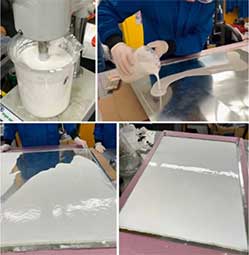Reversing Global Warming Effects With Cooling Paint

Through his startup, Planck Energies, MIE Associate Professor Yi Zheng is developing a cooling paint that reflects heat waves away from and draws existing heat out of buildings. It could reduce carbon emissions and electricity usage by reducing the need for air conditioning.
This article originally appeared on Northeastern Global News. It was published by Cynthia McCormick Hibbert. Main photo: Northeastern professor Yi Zheng conducts research on white cooling paint, a technology he says could cool the planet brush stroke by brush stroke. Photo by Matthew Modoono/Northeastern University
Is cooling paint the key to turning down the planet’s temperature dial?
The summer of 2024 has been another scorcher, with the highest temperature ever recorded by NASA on July 22 and the city of Phoenix reaching a milestone of 100 straight days of 100 degrees.
To Northeastern professor Yi Zheng, the news is another indication of the world’s need for a “cooling paint” technology being developed by his startup, Planck Energies.

Yi Zheng, associate professor of mechanical and industrial engineering, founded Planck Energies to find ways to mitigate worldwide environmental crises. Photo by Matthew Modoono/Northeastern University
Zheng says the passive technology could help dial down planetary temperatures, brush stroke by brush stroke, by cooling everything from buildings and rooftops to roadways and cycling paths.
“This has the potential to reduce air conditioning electricity and carbon emissions, which will have a significant global impact,” says Zheng, an associate professor of mechanical and industrial engineering.
“My plan actually is to apply passive cooling materials to all exposed surfaces all over the world,” he says. “Our ultimate goal is to address global warming and reduce the carbon footprint, greenhouse gas emissions.”
Experimental success
Also known as cool roof technology, the cooling paint is light or white in color to reflect rather than absorb heat.
The paint’s reflectivity is enhanced by smart optical components, Zheng says.
But the cool roof concept goes beyond shrugging off the impact of incident sunlight—also known as solar energy—he says.
It also uses nanotechnology to draw heat out of buildings and sends the infrared radiation to outer space via wavelengths not absorbed by the Earth’s atmosphere, Zheng says.
 |
 |
Rooftop cooling paint reduced the interior temperature of temporary storage sheds in Texas and Northeastern’s Burlington campus this summer by at least 5 degrees Celsius. Courtesy photos
“The Earth keeps receiving energy from the sun, but we never return energy back to the universe. That is a major issue. Passive cooling is one way we can effectively return the heat, excessive heat,” he says. “It’s the cooling of the whole world, the cooling of the Earth.”
Results from recent tests in Texas and on Northeastern’s Burlington campus have proved promising, with an indoor temperature drop of at least 5 degrees Celsius in storage sheds coated with the cooling paint, Zheng says.
Solving the ‘AC paradox’
He says successful implementation of the cooling paint could help alleviate or decrease the need for air conditioning.
In what is known as the AC paradox, growing temperatures and populations have driven up the demand for air conditioning, which in turn increases greenhouse emissions that contribute to continued global warming.
“Every degree of cooling this (paint) provides is a degree that doesn’t have to be cooled by an air conditioner,” Zheng says.
Read Full Story at Northeastern Global News